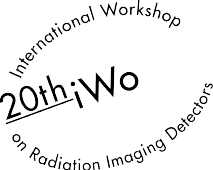Speaker
Description
We have been developing CdTe pixel detectors combined with an aluminum Schottky diode sensor and photon-counting ASICs [1-3]. The hybrid pixel detector was designed with a pixel size of 0.2 mm by 0.2 mm and an area of 19.0 mm by 20.0 mm or 38.2 mm by 40.2 mm. We have investigated Pt/CdTe/Al configuration by using high resistivity p-type single-crystal CdTe wafers of 750 μm in thickness. The front side (X-ray irradiation side) was processed with a single platinum-electrode. The back side was deposited with a 95 × 100 or 190 × 200 matrix of aluminum-electrodes. This electrode configuration of Pt/CdTe/Al-pixel has an advantage that a high Schottky barrier formed on the Al/CdTe interface leads us to operate the CdTe as an electron-collecting diode pixel detector. The photon-counting ASIC, SP8-04F10K, has a preamplifier, a shaper, 3-level window-type comparators and a 24-bits counter in each pixel.
The synchrotron radiation facility provides monochromatic X-rays but the beams have higher harmonics contamination. In the standard experiments higher energy contamination is regarded as background and eliminated by optical mirrors and/or an energy window of detector. However, high energy contribution is still usable as real signals from the sample. Therefore, we came up with a novel method measuring multi-energy diffractions at the same time. In this presentation we will describe simultaneous X-ray diffraction measurements with 25 keV (primary) and 75 keV (third order) X-ray beams performed by the dual window comparator mode.
We have performed a feasibility study for lattice spacing measurement by performing energy-dispersive Laue diffractions. White X-ray microbeams were irradiated to a polycrystalline copper alloy sample. Figure shows the results for a Laue diffraction pattern, energy plots measured by the threshold scans and the lattice spacing plots. X-ray energies were distributed between 60 and 120 keV in one diffraction spot, but the lattice spacings were almost constant. These were classified to three values. The averaged lattice spacings were calculated to be 1.294 (Å), 1.830 (Å) and 2.106 (Å). These correspond to the Cu(220), Cu(200) and Cu(111) surfaces. The present values are fairly in agreement with the standard values.
References
[1] H. Toyokawa et al., Nucl. Instr. and Meth. A636, S218-S221 (2011).
[2] H. Toyokawa et al., Journal of Physics: Conference Series, 425, 62014 (2013).
[3] H. Toyokawa et al., Journal of Instrumentation, 12, C01044 (2017).
